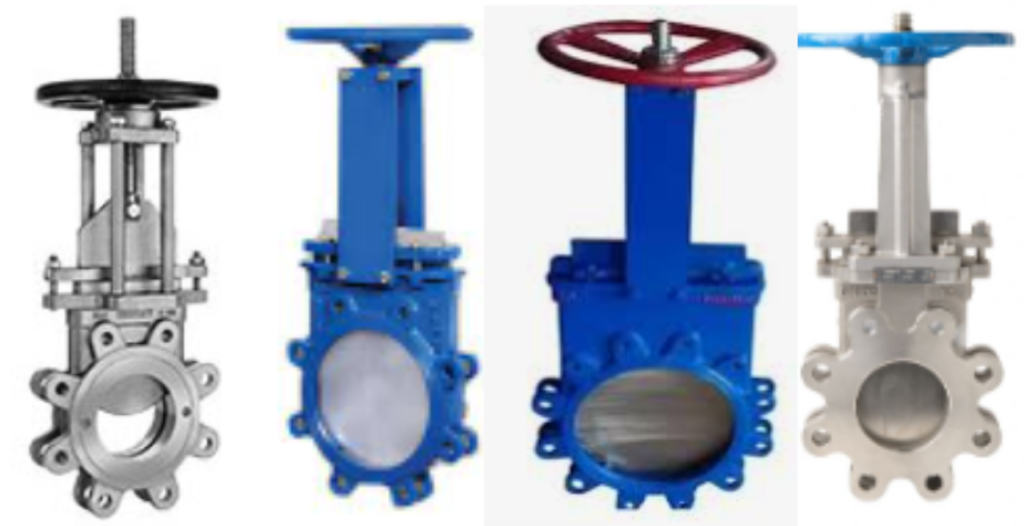SYSTEM COMPONENTS & ACCESSORIES
Knife Gate Valve (KGV) Manually Operated Type
A Knife Gate Valve (KGV) is a type of industrial valve used to control the flow of liquids or gases in a pipeline.
It is specifically designed for applications where a shutoff valve with a sharp-edged gate is required to cut through thick, viscous, or solid-laden media.
Here’s an overview of the Manually Operated Knife Gate Valve, including its working process, advantages, disadvantages, applications, materials of construction (MOC), and a summary:
Working Process:
Valve Body: The KGV typically consists of a circular or rectangular valve body with a gate mechanism inside. The gate is a flat, rectangular plate that slides horizontally across the flow path.
Gate Operation: In the manually operated version, the operator turns a handwheel or operates a lever to move the gate. As the gate moves, it either blocks or allows the flow of the medium through the valve.
Sealing Mechanism: KGVs often employ a resilient seat or sealing mechanism, such as rubber or elastomer, to provide a tight seal when the gate is closed. This helps prevent leakage.
Flow Control: When the gate is fully open, the valve allows unrestricted flow through the pipeline. When the gate is fully closed, it cuts off the flow completely.

-
Excellent Shutoff: Knife gate valves provide excellent shutoff capabilities, making them suitable for applications with thick slurries or solids.
-
Low Maintenance: They are relatively simple in design and have few moving parts, reducing the need for frequent maintenance.
-
Bi-Directional Sealing: Many KGVs offer bi-directional sealing, which means they can seal effectively in both flow directions.
-
Cost-Effective: They are often more cost-effective than other valve types for specific applications, such as handling abrasive or corrosive materials.
Disadvantages:
-
Limited Flow Control: Knife gate valves are primarily designed for on-off service and are not ideal for fine flow control applications.
-
Not Suitable for High-Pressure Applications: They may not be suitable for high-pressure systems due to the possibility of leakage around the gate.
-
Potential for Gate Damage: Abrasive media can cause wear and damage to the gate, reducing its lifespan.
Applications: Knife gate valves are commonly used in various industries and applications, including:
- Mining and mineral processing for handling slurries and abrasive materials.
- Pulp and paper industries for handling pulp and paper stock.
- Water and wastewater treatment plants for controlling flow and isolating pipelines.
- Chemical and petrochemical industries for handling corrosive fluids.
- Food processing for managing viscous or fibrous media.
Materials of Construction (MOC): The choice of materials for a knife gate valve depends on the specific application and the nature of the media being handled. Common materials of construction include:
- Valve Body: Cast iron, stainless steel, carbon steel, or other corrosion-resistant materials.
- Gate: Stainless steel, carbon steel, or coated with wear-resistant materials.
- Sealing: Elastomers or polymers suitable for the process conditions.
Summary:
A manually operated Knife Gate Valve (KGV) is a valve designed for applications where shutoff capabilities, especially in handling viscous or abrasive media, are crucial.
It operates by moving a flat gate horizontally to block or allow flow. Advantages include excellent shutoff capabilities, low maintenance, and cost-effectiveness.
However, it is not suitable for fine flow control or high-pressure applications and may require periodic gate maintenance due to wear.
KGVs find use in industries such as mining, pulp and paper, wastewater treatment, and chemical processing, with materials of construction chosen based on the application’s requirements.


 Sales & Marketing:
Sales & Marketing:  Service Supports:
Service Supports:  Website:
Website: 